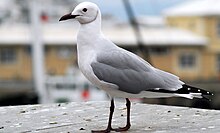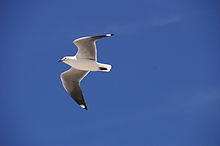Hardwood gull
| Hardwood gull | ||||||||||||
|---|---|---|---|---|---|---|---|---|---|---|---|---|

Hard-leaved gull in simple dress |
||||||||||||
| Systematics | ||||||||||||
|
||||||||||||
| Scientific name | ||||||||||||
| Chroicocephalus hartlaubii | ||||||||||||
| ( Bruch , 1853) |
The hard- leaved gull ( Chroicocephalus hartlaubii , Syn .: Larus hartlaubii ) is a medium-sized gull species that occurs on the west coast of southern Africa. The monotypic species was previously considered a subspecies of the herring head gull . Today it is assumed that it forms a super species with the two species of herring head gull and red-billed gull . It was named in honor of the zoologist Gustav Hartlaub , who himself described several species of plover species .
description
With a length of 37–39 cm and a wingspan of 89–92 cm, the hard-headed gull is slightly smaller than a black-headed gull . The weight is 235–340 g. The sexes do not differ.
The head, neck, underside, rump and tail are white in adult birds, the upper side is gray. Sometimes a pale gray head cap is indicated in the breeding plumage and bordered slightly more clearly towards the bottom, similar to the head drawing of the gray-headed gull . In the plain dress of the adult birds the head is pure white. Beak, legs and feet are dark red, the iris is brown. The hand- wing pattern is similar to that of the gray-headed gull with white, front hand-wings and white bases of the hand-wings, which are arched towards the black wing tip. The black of the wing tip runs out towards the arm wing. On the outer, mostly black hand wings, there are white subterminal fields that form a conspicuous mirror .
In juvenile birds, in contrast to other Chroicocephalus species , the head is pure white with no ear mark or other markings. Brown areas appear on the back and upper wings.
Distribution and existence
The breeding distribution of the hard arctic gull extends along the southwest African coast from central Namibia near Swakopmund to the southwest of the South African province of Western Cape at the level of Dyer Island , according to more recent information to Port Elizabeth .
The total population is estimated at 31,000 individuals or 12,000 to 15,300 breeding pairs based on counts in 31 colonies that resulted in a population of 12,000 pairs. In Namibia the population, which comprises around 1,600 pairs, is declining, in South Africa, where around 13,700 pairs breed in the Western Cape, it is increasing. 28% of the population can be found here on Robben Island . The main endangerment of the species is a low breeding success, which is due on the one hand to human and climatic influences, on the other hand to natural predators such as Dominican gulls , sacred ibises and cattle egrets . In addition, breeding pairs of common terns are often driven away . The breeding success is much lower when it is behind. Introduced predatory mammals on islands near the coast can also pose a threat. In colonies near airports, clutches are often willfully destroyed or birds are shot down to minimize the risk of bird strikes.
hikes
The hard-leaved gull is a resident bird in which only dismigrations can be observed along the south-west African coast in the area of brood distribution. Individual specimens get quite far north or as far as the South African east coast.
food
The hard-leaved gull feeds on marine invertebrates , small fish, worms, insects, and fishery and other debris. It catches its food by shock diving , swimming or in flight. Sometimes it can be found looking for food on plowed fields.
Reproduction
The hard-leaved gull breeds on flat, natural or artificial islands, dikes in sewage treatment plants and salt pans or on buildings. It nests in colonies of 10–1000 pairs and a nest distance of 1–2 m. Sometimes these are located near colonies of the common tern, from which the gulls are often driven away while they are breeding. There are contradicting information about the breeding season. Sometimes February or April to September is given as the period, and April to June as the peak. According to other sources, the breeding season is in the north in November and in the south in January. Breeding pairs have been found year-round in Swakopmund .
The nest is built on bare or sparsely overgrown ground, sometimes on roofs, and rarely up to 50 cm high in bushes. It consists of a hollow that is lined with plant material to varying degrees. The clutch usually comprises 1–3, more rarely up to 5 eggs. The breeding season is around 25 days, the young fledglings after 40 days.
literature
- Josep del Hoyo , Andrew Elliott, Jordi Sargatal (eds.): Handbook of the Birds of the World. Volume 3: Hoatzin to Auks. Lynx Edicions 1996, ISBN 978-84-87334-20-7 , p. 614.
- RJM Crawford, LG Underhill: Aspects of Breeding, Molt, Measurements and Population Trend of Hartlaub's Gull in Western Cape, South Africa. Waterbirds 26 (2), 2003, pp. 139-149, doi : 10.1675 / 1524-4695 (2003) 026 [0139: AOBMMA] 2.0.CO; 2
- Gerald S. Tuck, Hermann Heinzel : The sea birds of the world. Paul Parey Publishing House, Hamburg / Berlin 1980, ISBN 3-490-07818-7 .
Individual evidence
- ↑ a b c Del Hoyo et al. (1996), see literature
- ↑ a b c d e Crawford / Underhill (2003), see literature
- ↑ a b BirdLife Species Factsheet, see web links
Web links
- Larus hartlaubii in the Red List of Threatened Species of the IUCN 2008. Posted by: BirdLife International, the 144,212th Retrieved on February 8, 2012th
- BirdLife International: Species Factsheet - King Gull ( Larus hartlaubii ) . Retrieved February 8, 2012.
- Videos, photos and sound recordings of Larus hartlaubii in the Internet Bird Collection

